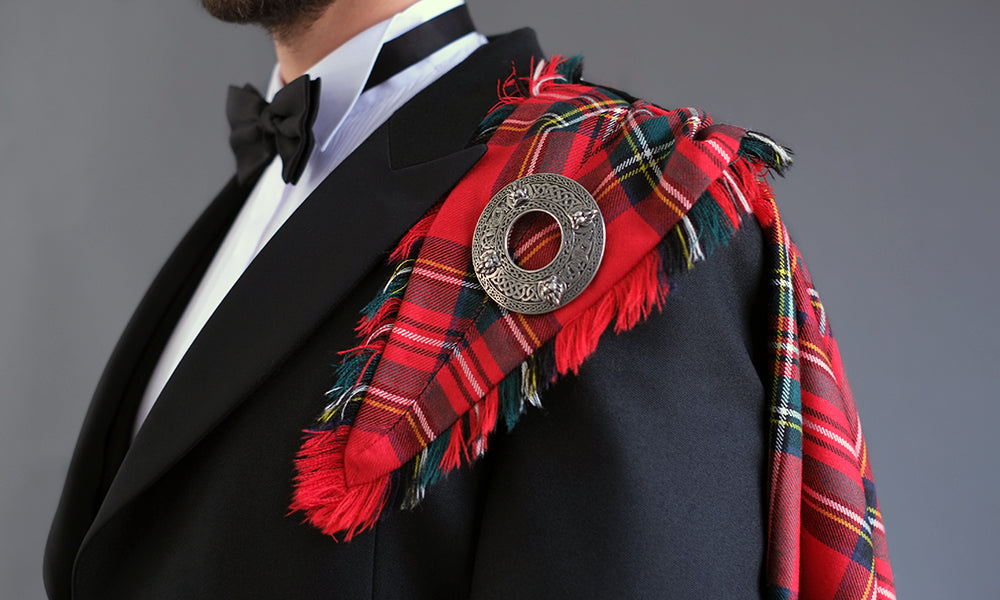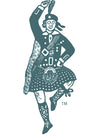So, you’ve been invited to attend a formal Scottish wedding, a Burn’s Night Supper, or – if you live in North America or Australia – a Tartan Day event. Sounds great. But it looks like all the men are going to be wearing kilts.
If you’ve never worn a kilt before the prospect of choosing the right tartan and then figuring out how to wear all the traditional highland dress properly can be a bit daunting.
But fear not, as Highland Store’s kilt shop team are on hand to help you out.
We put some frequently asked questions about how to choose and wear a kilt to them…
I NEED TO WEAR A KILT FOR A SCOTTISH WEDDING – DO I HAVE TO BUY ONE?
At Highland Store we offer you a choice of two options:
- Purchase your kilt and accessories from our ready-to-wear range.
- Have your kilt made-to-measure in your tartan of choice.
HOW DO I KNOW WHICH SCOTTISH TARTAN KILT TO CHOOSE?

Many of our customers are Scottish or have Scottish heritage and therefore usually know the tartan associated with their family or clan. If you do not have Scottish blood but want to wear a kilt then you can simply choose one you like.
However, if you’re planning to attend formal Scottish events it would be more considerate and respectful to choose a universally acceptable tartan such as Black Watch, Ben Lomond or Royal and Hunting Stewart.
Our men’s kilts page provides images of all the available tartans once you have selected your preferred kilt cloth.
But if you want to see and feel the tartans up close, an even better option would be to call us on +44 (0)207 405 5123 to book an in-store appointment. You’ll get to flick through the many tartan swatches we have available and fine tune your order
HOW MANY TYPES OF TARTAN DO YOU STOCK?
Our tartan suppliers produce more than 500 varieties. But don’t worry – we can help guide you through the various options so you end up with a tartan that both suits the occasion and suits your style and preferences. All the kilts we stock are traditionally made in Scotland from 100% premium worsted wool.
WHAT TYPE OF JACKET DO I NEED TO GO WITH A KILT?

The rules defining which jackets and vests (waistcoats) to wear to particular occasions have changed dramatically in recent times. In the past, Arrochar tweed jackets were only considered suitable for day (casual) wear but today many grooms choose this style for their weddings.

The most formal option is still the Bonnie Prince Charlie jacket, followed by the elegant Argyll. Bonnie Prince Charlie jackets are always worn with a waistcoat (usually with 3 buttons. although 5-button vests can also be worn) and can be adorned with a fly plaid over the shoulder. Argyll jackets can be worn with or without a 5-button waistcoat.
If you are wearing a waistcoat under your jacket, you typically leave your jacket unbuttoned.

WHAT TYPE OF SHIRT DO I NEED?
The rules governing Highland dress shirt etiquette have also been relaxed recently. However, whichever shirt you choose it should always be tucked into your kilt.
Generally, Prince Charlie jackets require a Victorian (or wing) collar shirt paired with a bow tie or ruched tie. Argyll and Arrochar tweed jackets look best with a standard collar shirt and a classic/tartan tie or ruche.
Ghillie shirts are still considered a traditional component of ‘day’ attire and are worn without jackets or neckwear. Instead of buttons, these traditional loose fitting shirts feature leather laces. Highland store stock them in black and in white.

HOW DO YOU MEASURE SOMEONE FOR A KILT?
Our kilt makers need three measurements to deliver a perfectly fitting kilt:
- Waist – the body circumference measured at the height of the naval.
- Hip – measured at the broadest point (usually 3 inches below the hip and including the buttocks).
- Length – from naval to floor. We ask our customers to kneel on a solid surface and keep their backs straight and heads high. The kilt hem should fall somewhere between the top and centre of the wearer’s kneecap.
The kilt is usually made so that it can be adjusted up in size, as people generally gain weight as time goes on. However, they can be made to adjust up or down a bit, and this might be something that you should consider at the outset.
WHAT OTHER ACCESSORIES DO I NEED FOR A COMPLETE HIGHLAND OUTFIT?
Once you have your kilt, jacket and waistcoat you will need to focus on the other components of your outfit:
Our range of traditional knitted hose (socks) and flashes (elasticated garters with decorative woven ribbons) help to complete your Highland dress outfit. We recommend you choose colours that complement or match your chosen kilt tartan.

- Sgian dubh (traditional knife)
The sgian dubh (pronounced skeean do) is a small knife worn tucked into the hose and flash. We stock a selection of sgian dubh – ranging from plain wooden handles to stag horn and pewter handles decorated with Celtic symbols.

Apart from the kilt, the sporran is probably the most well known item of male Scottish Highland dress. Kilts don’t have pockets so the sporran acts as a pouch or purse.
You can choose from three different types of sporran depending on how formal your event is – day sporrans, semi-dress sporrans, and dress sporrans. All the sporrans we stock at Highland Store are traditionally made in Scotland from leather, tweed and fur.

While not essential, traditional ghillie brogues with leather tasseled laces that criss-cross around the calf are a popular choice with a formal kilt outfit.

Kilt pins add a decorative touch to your kilt outfit. We recommend choosing pins that match the theme or style of your sporran cantle and belt buckle.

Traditionally, a kilt belt should only be worn with an Argyll jacket and no waistcoat but today this rule is widely ignored and belts have become a welcome part of most Highland outfits.

- Fly Plaid Certain formal events may require you to wear a fly plaid that matches your kilt

DO I PUT ON EACH ITEM OF HIGHLAND DRESS IN A PARTICULAR ORDER?
Although there are no specific rules the most practical order would be the following:
- Start with your woollen hose (socks) and flashes. Pull the hose over your knee and then place the elasticated garter just under the knee. Then turn down the top of the hose – leaving the colourful flashes at the side of the calf.
- Then put on your shoes – these could be your ghillie brogues. [Video showing how to tie the laces?]
- Next comes your shirt and then the tie or cravat.
- Now, tuck your sgian dubh into your hose (on the outside of the calf), leaving the just top of the handle showing. The sign dub is always on the side of your dominant hand.
- Now comes the kilt itself. First place the kilt pin. Traditionally, kilt pins are worn on the front right hand side, 2 inches from the bottom and 2 inches from the fringed edge of the kilt. The pin should only be attached to the apron (non-pleated front of the kilt) only.
- Then wrap the kilt around your waist keeping the pleats at the back. The right hand side crosses over first, then the left – each side fastens with a short buckle. The kilt should just be in line with the top of your knee.
- The sporran comes next. Place the chain straps through the loops at the back of the kilt. Then rest the chains on the top of the kilt buckles on each side.
- After the sporran comes the waistcoat and the final piece to put on is the jacket.
CAN YOU WEAR A KILT INFORMALLY?
Yes, kilts can be worn casually, usually paired with day or hunting sporrans, ghillie shirts or Aran sweaters. Often the ghillie brogues are replaced with chunky boots.
CAN I WEAR UNDERWEAR UNDERNEATH MY KILT?
Ah, one of the most common kilt-related questions. According to ancient tradition, kilts should be worn without underwear – “going commando” as we might say. Nowadays, though, I think most people wear underpants.
HOW FAR IN ADVANCE SHOULD I BOOK A KILT FITTING?
For a made-to-measure kilt, we recommend arranging an appointment six weeks prior to the function. Fast track services are however available at a premium.
DO I COME IN FOR A FITTING?
Yes, definitely. We recommend coming into our Great Russell Street kilt shop for fittings – especially if your purchase includes jackets and waistcoats. It’s best to try them on to find the right fit.
Having said that - kilt measurements can be provided remotely if you follow carefully our “size guide” instructions and have someone to assist you.
LET HIGHLAND STORE ORGANISE YOUR MADE-TO-MEASURE KILT
If you have an event coming up where you wish to wear traditional Highland dress or a kilt outfit, then get in touch – we’ll be happy to help you choose a tartan for your kilt and can advise on all the other clothing and accessories you might need.
To make kilt fitting appointments just phone us on +44 (0)207 405 5123 or email us at: sales@highlandstore.com.



